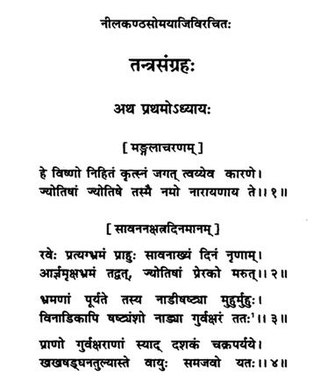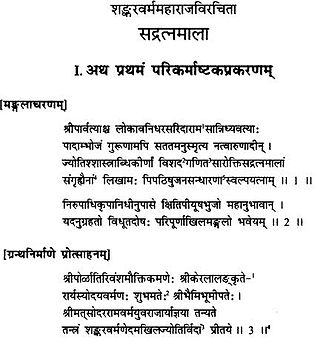Related Research Articles
A yuga, in Hinduism, is generally used to indicate an age of time.

Aryabhata or Aryabhata I was the first of the major mathematician-astronomers from the classical age of Indian mathematics and Indian astronomy. His works include the Āryabhaṭīya and the Arya-siddhanta.
Keļallur Nīlakaṇṭha Somayāji, also referred to as Keļallur Comatiri, was a major mathematician and astronomer of the Kerala school of astronomy and mathematics. One of his most influential works was the comprehensive astronomical treatise Tantrasamgraha completed in 1501. He had also composed an elaborate commentary on Aryabhatiya called the Aryabhatiya Bhasya. In this Bhasya, Nilakantha had discussed infinite series expansions of trigonometric functions and problems of algebra and spherical geometry. Grahapariksakrama is a manual on making observations in astronomy based on instruments of the time.
Bhāskara was a 7th-century Indian mathematician and astronomer who was the first to write numbers in the Hindu–Arabic decimal system with a circle for the zero, and who gave a unique and remarkable rational approximation of the sine function in his commentary on Aryabhata's work. This commentary, Āryabhaṭīyabhāṣya, written in 629, is among the oldest known prose works in Sanskrit on mathematics and astronomy. He also wrote two astronomical works in the line of Aryabhata's school: the Mahābhāskarīya and the Laghubhāskarīya.
Kamalakara was an Indian astronomer and mathematician, came from a learned family of scholars from Golagrama, a village situated in Maharashtra State near Partha-puri (Pathari) on the northern bank of the river Godāvarī. His father, Nrsimha, was born in 1586. Two of Kamalakara's three brothers were also astronomers and mathematicians. Divakara, who was the eldest of the brothers born in 1606, and Ranganatha who was youngest. Kamalākara learnt astronomy from his elder brother Divākara, who compiled five works on astronomy. His family later moved to Vārāṇasī.
Indian mathematics emerged and developed in the Indian subcontinent from about 1200 BCE until roughly the end of the 18th century CE. In the classical period of Indian mathematics, important contributions were made by scholars like Aryabhata, Brahmagupta, Bhaskara II, Varāhamihira, and Madhava. The decimal number system in use today was first recorded in Indian mathematics. Indian mathematicians made early contributions to the study of the concept of zero as a number, negative numbers, arithmetic, and algebra. In addition, trigonometry was further advanced in India, and, in particular, the modern definitions of sine and cosine were developed there. These mathematical concepts were transmitted to the Middle East, China, and Europe and led to further developments that now form the foundations of many areas of mathematics.
Mādhava of Sangamagrāma (Mādhavan) was an Indian mathematician and astronomer who is considered to be the founder of the Kerala school of astronomy and mathematics in the Late Middle Ages. Madhava made pioneering contributions to the study of infinite series, calculus, trigonometry, geometry and algebra. He was the first to use infinite series approximations for a range of trigonometric functions, which has been called the "decisive step onward from the finite procedures of ancient mathematics to treat their limit-passage to infinity".
Jyeṣṭhadeva was an astronomer-mathematician of the Kerala school of astronomy and mathematics founded by Madhava of Sangamagrama. He is best known as the author of Yuktibhāṣā, a commentary in Malayalam of Tantrasamgraha by Nilakantha Somayaji (1444–1544). In Yuktibhāṣā, Jyeṣṭhadeva had given complete proofs and rationale of the statements in Tantrasamgraha. This was unusual for traditional Indian mathematicians of the time. The Yuktibhāṣā is now believed to contain the essential elements of calculus like Taylor and infinity series. Jyeṣṭhadeva also authored Drk-karana, a treatise on astronomical observations.

The Kerala school of astronomy and mathematics or the Kerala school was a school of mathematics and astronomy founded by Madhava of Sangamagrama in Tirur, Malappuram, Kerala, India, which included among its members: Parameshvara, Neelakanta Somayaji, Jyeshtadeva, Achyuta Pisharati, Melpathur Narayana Bhattathiri and Achyuta Panikkar. The school flourished between the 14th and 16th centuries and its original discoveries seem to have ended with Narayana Bhattathiri (1559–1632). In attempting to solve astronomical problems, the Kerala school independently discovered a number of important mathematical concepts. Their most important results—series expansion for trigonometric functions—were described in Sanskrit verse in a book by Neelakanta called Tantrasangraha, and again in a commentary on this work, called Tantrasangraha-vakhya, of unknown authorship. The theorems were stated without proof, but proofs for the series for sine, cosine, and inverse tangent were provided a century later in the work Yuktibhasa, written in Malayalam, by Jyesthadeva, and also in a commentary on Tantrasangraha.

The Surya Siddhanta is a Sanskrit treatise in Indian astronomy dated to 4th to 5th century, in fourteen chapters. The Surya Siddhanta describes rules to calculate the motions of various planets and the moon relative to various constellations, diameters of various planets, and calculates the orbits of various astronomical bodies. The text is known from a 15th-century CE palm-leaf manuscript, and several newer manuscripts. It was composed or revised probably c. 800 CE from an earlier text also called the Surya Siddhanta. The Surya Siddhanta text is composed of verses made up of two lines, each broken into two halves, or pãds, of eight syllables each.

Aryabhatiya or Aryabhatiyam, a Sanskrit astronomical treatise, is the magnum opus and only known surviving work of the 5th century Indian mathematician Aryabhata. Philosopher of astronomy Roger Billard estimates that the book was composed around 510 CE based on historical references it mentions.

Yuktibhāṣā, also known as Gaṇita-yukti-bhāṣā and Gaṇitanyāyasaṅgraha, is a major treatise on mathematics and astronomy, written by the Indian astronomer Jyesthadeva of the Kerala school of mathematics around 1530. The treatise, written in Malayalam, is a consolidation of the discoveries by Madhava of Sangamagrama, Nilakantha Somayaji, Parameshvara, Jyeshtadeva, Achyuta Pisharati, and other astronomer-mathematicians of the Kerala school. It also exists in a Sanskrit version, with unclear author and date, composed as a rough translation of the Malayalam original.

Tantrasamgraha, or Tantrasangraha, is an important astronomical treatise written by Nilakantha Somayaji, an astronomer/mathematician belonging to the Kerala school of astronomy and mathematics. The treatise was completed in 1501 CE. It consists of 432 verses in Sanskrit divided into eight chapters. Tantrasamgraha had spawned a few commentaries: Tantrasamgraha-vyakhya of anonymous authorship and Yuktibhāṣā authored by Jyeshtadeva in about 1550 CE. Tantrasangraha, together with its commentaries, bring forth the depths of the mathematical accomplishments the Kerala school of astronomy and mathematics, in particular the achievements of the remarkable mathematician of the school Sangamagrama Madhava. In his Tantrasangraha, Nilakantha revised Aryabhata's model for the planets Mercury and Venus. According to George G Joseph his equation of the centre for these planets remained the most accurate until the time of Johannes Kepler in the 17th century.
Hindu units of time are described in Hindu texts ranging from microseconds to trillions of years, including cycles of cosmic time that repeat general events in Hindu cosmology. Time is described as eternal. Various fragments of time are described in the Vedas, Manusmriti, Bhagavata Purana, Vishnu Purana, Mahabharata, Surya Siddhanta etc.
Puthumana Somayaji (c.1660–1740) was a 17th-century astronomer-mathematician from Kerala, India. He was born into the Puthumana or Puthuvana family of Sivapuram. The most famous work attributed to Puthumana Somayaji is Karanapaddhati which is a comprehensive treatise on Astronomy.
Madhava's sine table is the table of trigonometric sines constructed by the 14th century Kerala mathematician-astronomer Madhava of Sangamagrama. The table lists the jya-s or Rsines of the twenty-four angles from 3.75° to 90° in steps of 3.75°. Rsine is just the sine multiplied by a selected radius and given as an integer. In this table, as in Aryabhata's earlier table, R is taken as 21600 ÷ 2π ≈ 3437.75.

Sadratnamala is an astronomical-mathematical treatise in Sanskrit written by Sankara Varman, an astronomer-mathematician of the Kerala school of mathematics, in 1819. Even though the book has been written at a time when western mathematics and astronomy had been introduced in India, it is composed purely in the traditional style followed by the mathematicians of the Kerala school. Sankara Varman has also written a detailed commentary on the book in Malayalam.
In astronomy, Jyotirmimamsa is a treatise on the methodology of astronomical studies authored by Nilakantha Somayaji (1444–1544) in around 1504 CE. Nilakantha somayaji was an important astronomer-mathematician of the Kerala school of astronomy and mathematics and was the author of the much celebrated astronomical work titled Tantrasamgraha. This book stresses the necessity and importance of astronomical observations to obtain correct parameters for computations and to develop more and more accurate theories. It even discounts the role of revealed wisdom and divine intuitions in studying astronomical phenomena. Jyotirmimamsa is sometimes cited as proof to establish that modern methodologies of scientific investigations were known to ancient and medieval Indians. Neelkantha Somayaji insisted that computational results should tally with that of observations and astronomical parameters and constants should be revised periodically. To come to more precise conclusions, Neelkantha Somayaji have discussions with the astronomer and mathematicians of other schools.
In mathematics, a Madhava series is one of the three Taylor series expansions for the sine, cosine, and arctangent functions discovered in 14th or 15th century in Kerala, India by the mathematician and astronomer Madhava of Sangamagrama or his followers in the Kerala school of astronomy and mathematics. Using modern notation, these series are:
Kriyakramakari (Kriyā-kramakarī) is an elaborate commentary in Sanskrit written by Sankara Variar and Narayana, two astronomer-mathematicians belonging to the Kerala school of astronomy and mathematics, on Bhaskara II's well-known textbook on mathematics Lilavati. Kriyakramakari, along with Yuktibhasa of Jyeshthadeva, is one of the main sources of information about the work and contributions of Sangamagrama Madhava, the founder of Kerala school of astronomy and mathematics. Also the quotations given in this treatise throw much light on the contributions of several mathematicians and astronomers who had flourished in an earlier era. There are several quotations ascribed to Govindasvami a 9th-century astronomer from Kerala.
References
- 1 2 Charles Whish (1834), "On the Hindu Quadrature of the circle and the infinite series of the proportion of the circumference to the diameter exhibited in the four Sastras, the Tantra Sahgraham, Yucti Bhasha, Carana Padhati and Sadratnamala", Transactions of the Royal Asiatic Society of Great Britain and Ireland, 3 (3), Royal Asiatic Society of Great Britain and Ireland: 509–523, doi:10.1017/S0950473700001221, JSTOR 25581775
- ↑ Datta, Bibhutibhushan; A.N. Singh (1993). "Uses of series in India". Indian Journal of History of Science. 28 (3): 103–129.
- 1 2 3 Bag, Amulya Kumar (1966). "Trigonometrical series in the Karanapaddhati and the probable date of the text" (PDF). Indian Journal of History of Science. 1 (2). Indian National Science Academy: 98–106.[ permanent dead link ]
- ↑ Rajaraja Varma Vadakkumkuur. History of Sanskrit Literature in Kerala (1–6 Volumes). Vol. 1. p. 529.
- ↑ N. Gopalakrishnan (2004). Baharatheeya Vijnana / Saastra Dhaara ( Handbbok of Ancient Indian Scientific Books) (PDF). Heritage Publication Series. Vol. 78. Thiruvanannthapuram, India: Indian Institute of Scientific Heritage. pp. 18–20. Retrieved 12 January 2010.[ permanent dead link ]
Venketeswara Pai R, K Ramasubramanian, M S Sriram and M D Srinivas, Karanapaddhati of Putumana Somayaji, Translation with detailed Mathematical notes, Jointly Published by HBA (2017) and Springer (2018).